Printable primary worksheets
All of our resources come complete with answer sheets to save time for busy teachers and parents. Input your child’s scores and keep track of your child's progress.
worksheet plans from £3.20/monthAll of our resources come complete with answer sheets to save time for busy teachers and parents. Input your child’s scores and keep track of your child's progress.
worksheet plans from £3.20/month New
New
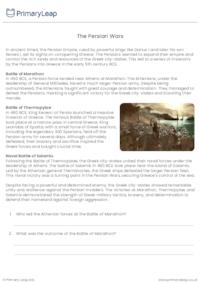
Engage your KS2 students in the captivating history of ancient Greece with this educational worksheet focused on how the Greek city-states united to defeat the Persian Invasion. Students will explore key battles and heroic acts that shaped ancient Greek history. Learning Objectives:Understand the historical context of the Persian Invasion and its significance in ancient Greek history.Explore the key battles of Marathon, Thermopylae, and Salamis, and their impact on Greek civilisation.Analyse the strategies, leadership, and unity demonstrated by the Greek city-states during the Persian Wars.Bring the epic saga of ancient Greek history to life with this fun activity, designed to inspire curiosity and learning among KS2 students. Dive into the heroic tales of Marathon, Thermopylae, and Salamis, and discover the enduring legacy of Greek resilience against adversity.
 New
New
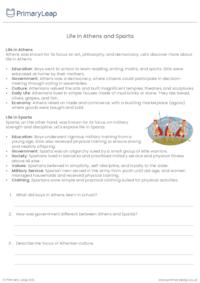
Embark on a captivating journey into ancient Greece with this KS2 history worksheet exploring life in two prominent city-states: Athens and Sparta. Children will delve into the unique characteristics of each city-state, from education and government to culture and societal values.Learning Objectives:Understand the key differences between Athens and Sparta in terms of education, government, culture, and societal values.Explore the importance of art, philosophy, and democracy in Athenian society.Investigate the focus on military strength and discipline in Spartan society.Reflect on the roles of individuals in Athenian and Spartan communities.Interactive Elements:Comprehension Questions: Engage students with simple yet thought-provoking questions based on the worksheet content.Reflective Activities: Encourage creative thinking through imaginative tasks, such as drawing a picture or writing a diary entry from the perspective of individuals in ancient Athens or Sparta.Benefits:Provides a comprehensive understanding of life in ancient Greek city-states.Encourages critical thinking and analytical skills through comparative analysis.Promotes historical empathy by exploring the daily lives and values of ancient Athenians and Spartans.Fosters appreciation for the cultural diversity and historical significance of ancient Greece.This engaging KS2 history worksheet aims to deepen students' knowledge of ancient Greek civilisation through an exploration of life in Athens and Sparta. By examining different aspects of these city-states, students will gain insights into the rich tapestry of ancient Greek history and society.
 New
New
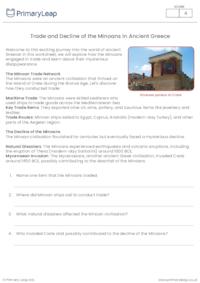
KS2 Trade and Decline of the Minoans in Ancient Greece ActivityThis KS2 history worksheet delves into the intriguing topic of the Minoans, an ancient civilisation that thrived on the island of Crete during the Bronze Age. Students will explore how the Minoans engaged in trade across the Mediterranean Sea and discover the factors that led to their mysterious decline.
 New
New
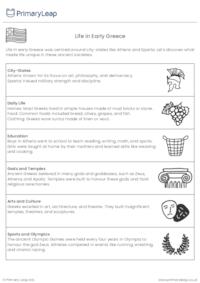
In this engaging KS2 history worksheet, kids will delve into the intriguing world of ancient Greece to discover what life was like in early Greek civilisation. Through captivating text and exploration of key aspects such as daily life, culture, education, and religious beliefs, students will gain a deeper understanding of this influential period in history. Learning Objectives:Explore the daily activities, food, and clothing of ancient Greeks.Learn about the city-states of Athens and Sparta and their distinct characteristics.Discover the roles of education, art, and religion in ancient Greek society.Understand the significance of gods and goddesses in ancient Greek culture.Explore the origins and traditions of the ancient Olympic Games.This worksheet provides an exciting opportunity for KS2 students to immerse themselves in the vibrant world of ancient Greece, fostering a deeper appreciation for its history, culture, and enduring legacy.
 New
New
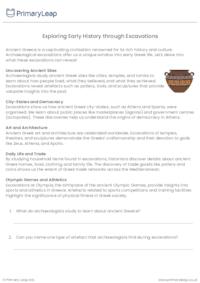
KS2 Ancient Greece: Exploring Early History through ExcavationsThis KS2 history worksheet delves into the intriguing world of ancient history through the lens of archaeological excavations. Kids will embark on a journey to uncover the secrets of early civilisations, particularly focusing on Ancient Greece, by exploring the discoveries made through excavations. This versatile worksheet can be used both in the classroom and at home.
 New
New
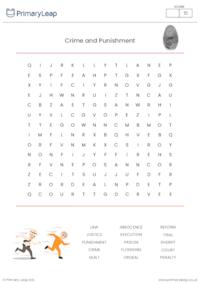
This KS2 word search activity will help to reinforce vocabulary related to crime and punishment in history. Students will search for key words associated with law enforcement, judicial systems, and historical methods of punishment. Enjoy incorporating this word search into your lesson plans!Key Learning Objectives:Enhance students' understanding of terminology related to crime and punishment.Reinforce knowledge of historical concepts and practices in law enforcement.Encourage vocabulary retention and spelling practice in a fun and engaging way.
 New
New
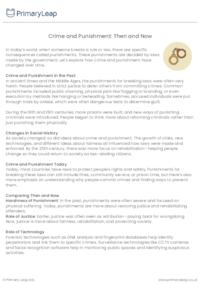
This KS2 history resource focuses on exploring the evolution of crime and punishment from ancient times to the present day. Students will learn about the harsh punishments of the past, the societal changes that influenced ideas about justice, and the modern approaches to addressing crime and rehabilitation. By understanding the past, children can develop a deeper appreciation for the principles that shape modern legal systems. The resource encourages students to consider the role of fairness, rehabilitation, and technology in addressing crime in society today.
 New
New
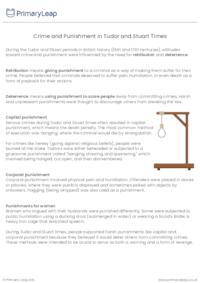
Crime and Punishment in Tudor and Stuart Times worksheetThis KS2 history worksheet explores the attitudes towards crime and punishment during the Tudor and Stuart periods in British history (16th and 17th centuries). Students will learn about the concepts of retribution and deterrence and how they shaped the justice system during this era. They will also discover different methods of punishment, including capital and corporal punishment, and how they were used to maintain order and discourage crime.
 New
New
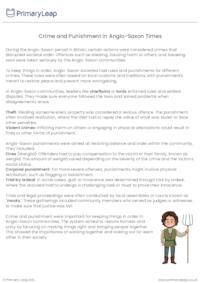
This worksheet explores crime and punishment during the Anglo-Saxon period in Britain. Students will learn about the laws, customs, and punishments that kept order in these ancient communities. They will discover how leaders enforced justice and how crimes were addressed in Anglo-Saxon society.
 New
New
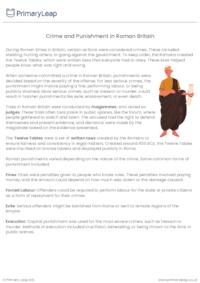
This worksheet explores the concept of crime and punishment during Roman times in Britain. Students will learn about the laws established by the Romans, known as the Twelve Tables, and how they governed societal behaviour. They will discover various crimes that were considered serious offences, as well as the corresponding punishments imposed by Roman authorities.Through engaging reading material and comprehension questions, students will gain insights into Roman justice systems and how they influenced legal practices that continue to shape modern law and order.
 New
New
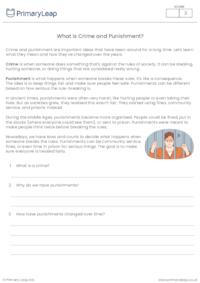
This worksheet introduces KS2 students to the concepts of crime and punishment throughout history. It provides a simplified explanation of what crime and punishment are, their importance in society, and how they have changed over time. The worksheet includes a reading passage followed by comprehension questions to reinforce understanding. It aims to spark discussion and critical thinking about historical changes in law and justice.Learning Objectives:Understand the definitions of crime and punishment.Recognise why punishments are important in society.Identify historical changes in methods of punishment.
 New
New
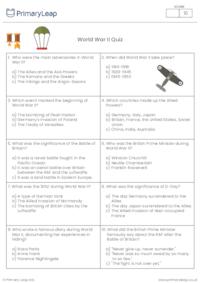
This worksheet is designed to test KS2 students' knowledge of World War II, covering key events, people, and concepts related to this significant historical period. The quiz consists of multiple-choice questions that encourage critical thinking and recall of information learned about World War II. Key Topics Covered:Start and end dates of World War IIAllied Powers and Axis PowersSignificant battles and events (e.g., Battle of Britain, D-Day)Important figures (e.g., Winston Churchill, Anne Frank)Impact of the war on different regions and countriesLearning Outcomes:Enhanced knowledge of World War II historyImproved comprehension of key historical events and figuresDevelopment of critical thinking and analytical skills through multiple-choice questions
 New
New
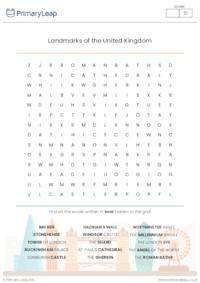
UK Landmarks Word Search ActivityGet ready for an exciting journey across the United Kingdom with this fun word search puzzle! Perfect for KS2 students, this worksheet lets you explore iconic landmarks while boosting your vocabulary and spelling skills. Search for famous places like Big Ben, Stonehenge, and Buckingham Palace hidden in the grid. It's a fantastic way to learn more about the UK's geography and history while having a blast! Ideal for classroom activities, independent learning, or a relaxing brain teaser at home.
 New
New
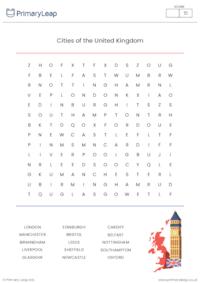
Cities of the United Kingdom Word SearchEmbark on an exciting journey across the United Kingdom with this fun word search puzzle! This worksheet is designed for kids to test their knowledge of major cities in the UK while honing their vocabulary and spelling skills. Students will search for the names of 15 prominent cities scattered throughout the grid, ranging from London to Belfast. As students search for each city, they will reinforce their understanding of UK geography and familiarise themselves with key urban centres. Educators can use this worksheet as a fun and interactive activity to supplement geography lessons or as a standalone exercise to promote independent learning.
 New
New
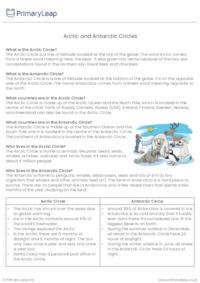
This worksheet invites pupils to delve into the fascinating realms of the Arctic Circle and the Antarctic Circle. Through a series of thought-provoking questions and informative text, students will explore the geography, wildlife, climate, and human presence in these polar regions. By comparing and contrasting the Arctic and Antarctic Circles, students will deepen their understanding of the unique characteristics and environmental challenges faced by these remote areas. Educators can use this worksheet to foster critical thinking skills, geographical literacy, and awareness of global environmental issues among students. The worksheet provides a comprehensive overview of the Arctic and Antarctic Circles, incorporating engaging facts and prompts to encourage active learning and discussion.
 New
New
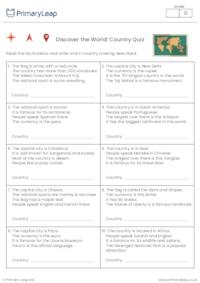
Kids can test their knowledge of countries around the world with our fun geography quiz! Each section provides clues about a specific country, prompting students to identify the country based on the given information. By deciphering clues related to geography, culture, landmarks, and national symbols, students will enhance their understanding of global diversity and geography. Educators can use this worksheet to encourage critical thinking and geographical literacy among KS2 students. Answers are provided to facilitate self-assessment and reinforce learning. This activity fosters independent learning and cultural awareness while providing an enjoyable and educational experience for students.
 New
New
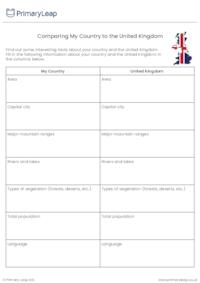
This handy geography worksheet will help students to compare and contrast their own country with the United Kingdom. Through guided inquiry and research, students will explore various aspects including geography, culture, climate, population, and more. By engaging in this comparative analysis, students will deepen their understanding of global diversity and geography while honing their research and critical thinking skills. This activity promotes independent learning and encourages students to consider the diverse cultural aspects and geographical features of both countries.
 New
New
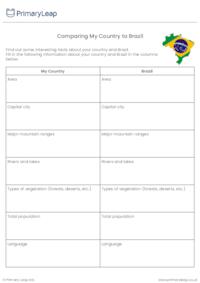
This worksheet invites upper KS2 students to compare and contrast the characteristics of their own country with Brazil. Through guided inquiry and research, students will investigate various aspects including geography, culture, climate, population, and more. By engaging in this comparative analysis, students will deepen their understanding of global diversity and geography while honing their research and critical thinking skills
 New
New
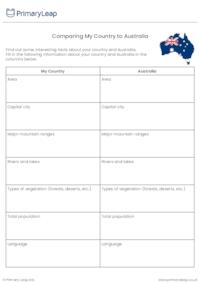
This worksheet provides students with an opportunity to compare and contrast the human and physical features of their own country with Australia. By examining various aspects such as size, physical geography, population, climate, and cultural elements, students will develop a deeper understanding of global diversity and geography. The worksheet prompts students to research and gather information about their own country and Australia, encouraging independent learning and critical thinking skills.
 New
New
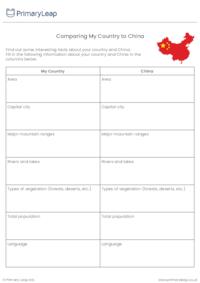
This worksheet provides students with an opportunity to compare and contrast the human and physical features of their own country with China. By examining various aspects such as size, physical geography, population, climate, and cultural elements, students will develop a deeper understanding of global diversity and geography. The worksheet prompts students to research and gather information about their own country and China, encouraging independent learning and critical thinking skills.
 New
New
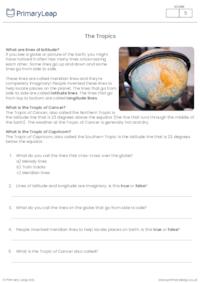
This worksheet is designed to introduce upper KS2 students to the concept of latitude, focusing on lines of latitude and the Tropics of Cancer and Capricorn. Through engaging text and interactive questions, students will learn about the imaginary nature of latitude lines, their purpose in locating places on Earth, and the significance of the Tropic of Cancer and Tropic of Capricorn in Earth's geography. Learning Objectives:Understand the concept of latitude and its role in geography.Identify the purpose of latitude lines in locating places on Earth.Learn about the Tropic of Cancer and Tropic of Capricorn and their significance in Earth's geography.Develop critical thinking skills through interactive questions and activities.This worksheet provides an engaging introduction to latitude lines and the Tropics of Cancer and Capricorn for upper KS2 students. By exploring these concepts through interactive questions and informative text, students will develop a deeper understanding of geographic navigation and Earth's geographical features. Further exploration of maps and globes can enhance students' spatial awareness and geographic literacy.
 New
New
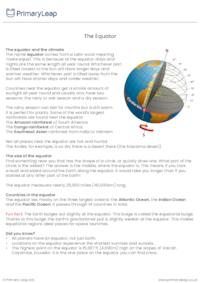
This handy worksheet is designed for upper KS2 students, emphasising the importance of the equator within the geography curriculum's locational knowledge strand. Using captivating text and thought-provoking questions, students will explore the equator's origins, its influence on Earth's climate, its contribution to shaping global geography, and its significance in space exploration. Moreover, the worksheet incorporates a hands-on activity aimed at visualising the equator's size and position, offering students a comprehensive grasp of this fundamental geographic element.
 New
New
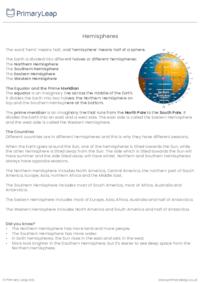
KS2 Hemispheres ActivityThis KS2 geography worksheet introduces students to the concept of hemispheres and their significance in understanding Earth's geography. Through engaging text and thought-provoking questions, students will explore the division of Earth into different hemispheres, the role of the Equator and Prime Meridian, and how countries in different hemispheres experience seasons differently. Learning Objectives:Identify and describe the four main hemispheres of the Earth.Understand the significance of the Equator and Prime Meridian in dividing the Earth.Recognise how the tilt of the Earth's axis influences seasonal variations in different hemispheres.Develop locational knowledge by identifying countries in various hemispheres.This worksheet is designed to enhance students' locational knowledge and understanding of Earth's geography. Encourage students to actively engage with the text and discuss their responses to the questions to deepen their understanding of hemispheres and their significance. Additionally, encourage students to explore maps and atlases to reinforce their understanding of country locations in different hemispheres.
 Free
Free
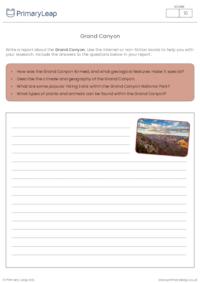
In this KS2 geography worksheet, students will embark on an exciting exploration of the majestic Grand Canyon. Through research and inquiry, they will discover the geological wonders, diverse ecosystems, and cultural significance of this iconic natural landmark. This worksheet is designed to enhance students' geographical knowledge, research skills, and appreciation for the natural world. Objective:Investigate the formation, climate, geography, and biodiversity of the Grand Canyon.Develop research and report writing skills.Foster an understanding of the importance of natural landmarks and conservation.
 New
New
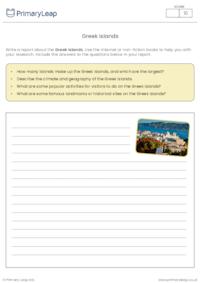
In this geography worksheet, students will embark on a virtual journey to the enchanting Greek Islands. They will have the opportunity to learn about the geography, climate, attractions, and historical significance of these beautiful islands. Through research and exploration, students will discover fascinating facts and create a comprehensive report about the Greek Islands.Objective:Research and report on key aspects of the Greek Islands, including their geography, climate, popular activities, and famous landmarks.Students will conduct research using the Internet or non-fiction books to gather information about the Greek Islands.They will use the provided questions as a guide to structure their report.Encourage students to include detailed descriptions and interesting facts in their report.Emphasise the importance of accurate information and proper citation of sources.Once completed, students will have a deeper understanding of the Greek Islands and their significance.
 New
New
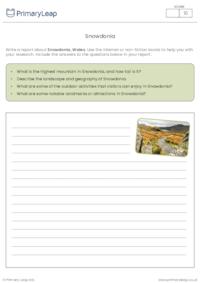
This informative worksheet is designed to engage KS2 students in researching and writing a report about Snowdonia, Wales. Through the use of the Internet or non-fiction books, students will gather information about Snowdonia's geography, attractions, and outdoor activities. By answering specific questions provided in the worksheet, students will deepen their understanding of this stunning natural landscape and develop their research and writing skills.The worksheet prompts students to explore the following questions:What is the highest peak in Snowdonia, and how tall is it?Describe the landscape and geography of Snowdonia.What are some of the outdoor activities that visitors can enjoy in Snowdonia?What are some notable landmarks or attractions in Snowdonia?Teachers can use this worksheet as a standalone assignment or as part of a broader unit on geography or British landmarks. It provides a structured framework for students to conduct research, organise information, and practise writing skills.
 New
New
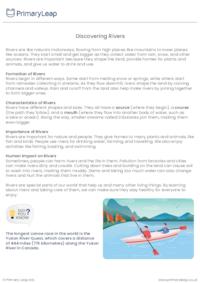
This handy geography worksheet is designed to help KS2 students learn about the fascinating world of rivers. Through a series of thought-provoking questions and activities, students will explore the formation, characteristics, importance, and human impact on rivers. It provides educators with a valuable resource for teaching key concepts in KS2 geography while promoting curiosity and environmental awareness among students.
 New
New
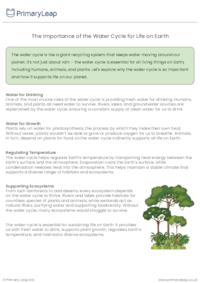
Design a poster activityThe water cycle is like a giant recycling system that keeps water moving around our planet. It's not just about rain – the water cycle is essential for all living things on Earth, including humans, animals, and plants. This handy worksheet provides KS2 students with information about the importance of the water cycle for life on Earth, including examples of how humans, animals, and plants depend on it. Students can use this information to create a poster illustrating these key points.
 Free
Free
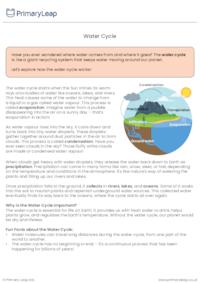
Exploring the Water Cycle - KS2 Worksheet ActivityThis engaging worksheet activity focuses on exploring the water cycle with KS2 students. Through a series of thought-provoking questions and activities, students will deepen their understanding of the water cycle's key stages and importance in Earth's ecosystems. This activity is designed to be interactive, encouraging students to reflect, discuss, and apply their knowledge in creative ways.Worksheet Content:The worksheet includes a series of questions related to the text about the water cycle, covering topics such as evaporation, condensation, precipitation, and the importance of the water cycle.Students are prompted to reflect on their own observations and experiences related to the water cycle, as well as to consider hypothetical scenarios and apply their knowledge creatively.The worksheet also includes multiple-choice questions to assess students' comprehension of key concepts and processes involved in the water cycle.
 New
New
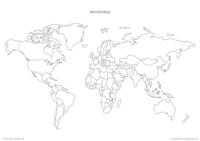
Blank World Map This blank world map is a versatile and valuable resource for educators teaching KS2 geography. Whether used as a standalone activity or integrated into lesson plans, this map encourages kids to explore and engage with key geographical concepts. Educators can use the map as a tool for teaching kids about the location of different countries around the world. Students can label countries, capital cities, and key landmarks.Whether used for basic geographical identification or more complex analysis of global issues, this map provides students with a foundation for understanding the world around them and encourages active exploration and learning.
 New
New
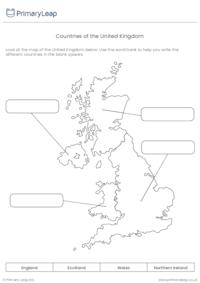
Countries of the United Kingdom ActivityThis engaging worksheet is designed to reinforce students' locational knowledge of the countries comprising the United Kingdom: England, Scotland, Wales, and Northern Ireland. By accurately labelling these countries on a map, students will deepen their understanding of UK geography and develop spatial awareness skills.The primary objective of this worksheet is to familiarise students with the geographical locations of the countries within the United Kingdom. Through this activity, students will enhance their ability to identify and differentiate between these countries on a map. Encourage students to compare and contrast the countries of the United Kingdom in terms of size, population, and geographical features.
 New
New
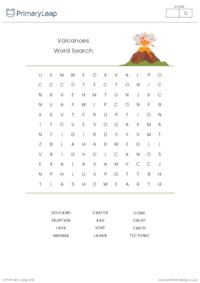
Embark on an exciting journey into the world of volcanoes with this engaging KS2 geography word search! Designed to captivate young minds and reinforce key vocabulary related to volcanic activity, this word search is an ideal educational tool for parents and teachers alike. Usage:Perfect for classroom activities, homework assignments, or educational enrichment at home.Suitable for individual or group work, fostering collaboration and peer learning.
 New
New
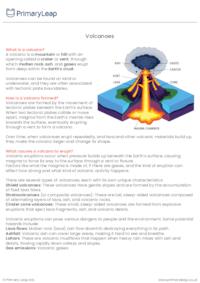
UKS2 Volcanoes ActivityThis engaging worksheet introduces students (UKS2) to the fascinating world of volcanoes. Through clear and concise explanations, students will learn about the formation of volcanoes, why they erupt, different types of volcanoes, associated dangers, and safety precautions during eruptions. Accompanied by a colourful diagram, this worksheet offers a comprehensive overview of volcanoes, making it an excellent resource for educators, parents, and teachers seeking to enhance their students' understanding of Earth's dynamic geological features. This resource can either be used in the classroom or at home.
 New
New
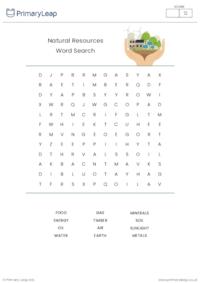
Natural Resources Word SearchWord searches are not just fun puzzles; they're valuable educational tools that can enhance learning experiences for KS2 students in geography and beyond. Whether used in classrooms or at home, word searches offer numerous benefits for young learners. They provide an engaging way for students to familiarise themselves with vocabulary related to natural resources. By searching for and identifying words like "water," "minerals," and "energy," students reinforce their understanding of key terms essential for geography lessons.Word searches offer a fun and engaging way to learn, making them suitable for both classroom use and independent study at home. Students are motivated to complete the puzzle as they enjoy the challenge of finding and circling the hidden words. By incorporating word searches focused on natural resources into your KS2 geography curriculum, you can create an enriching learning experience that sparks curiosity and deepens students' understanding of the world around them. Whether used as standalone activities or integrated into broader lesson plans, word searches offer a dynamic and effective way to engage students in exploring the fascinating topic of natural resources.
 New
New
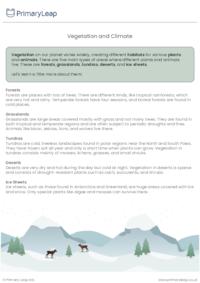
This engaging worksheet is designed to introduce KS2 students to the fascinating world of Earth's biomes – the diverse habitats that shape our planet's landscapes and support a wide variety of plant and animal life.Students will explore five main types of biomes: forests, grasslands, tundras, deserts, and ice sheets. They'll learn about the unique characteristics of each biome, from the towering trees of forests to the frozen expanses of ice sheets.Aligned with the UK national curriculum, this worksheet encourages students to match biome characteristics, identify vegetation types, and understand the environmental factors that influence each biome. It's a fantastic resource for sparking curiosity and deepening geographical knowledge.
 New
New
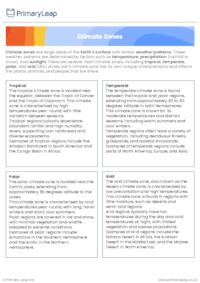
KS2 Climate Zones WorksheetThis KS2 geography worksheet, "Climate Zones," is designed to help educators teach students about the different climate zones found on Earth. Through engaging descriptions and thought-provoking questions, students will explore the characteristics of tropical, temperate, polar, and arid climate zones.The worksheet begins with brief descriptions of each climate zone, providing key information about their locations, temperature patterns, vegetation, and examples of regions within each zone. Students will learn about the unique features of tropical regions near the equator, temperate regions with distinct seasons, polar regions with extreme cold temperatures, and arid regions with low precipitation levels.Educators can use this worksheet as part of their geography curriculum to introduce or reinforce the concept of climate zones. It can be used in classroom settings, as homework assignments, or as supplementary material for independent study. By completing this worksheet, students will gain a deeper understanding of the diverse climates that exist across the globe and the factors that influence them.
 New
New
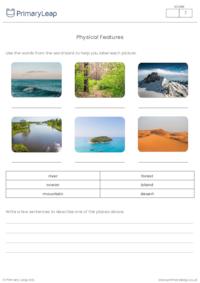
Our Labelling Physical Features activity is designed to engage KS1 students in learning about key geographical features such as mountains, oceans, deserts, rivers, forests, and islands. This worksheet aims to develop students' understanding of these features and their significance in shaping our planet's landscapes.How will this worksheet help my students?The objective of this worksheet is to help students identify and label different physical features correctly, enhancing their knowledge of basic geography concepts.
 New
New
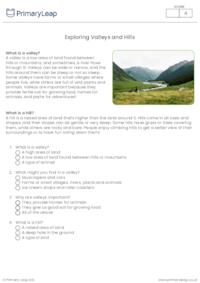
KS1 Valleys and Hills WorksheetIn this worksheet, students will explore the characteristics and significance of valleys and hills through simple and relatable descriptions. They will learn about the defining attributes of valleys, including their low-lying nature, association with hills or mountains, and the presence of rivers. Additionally, students will discover the various features of hills, such as their raised elevation, diverse shapes, and the enjoyment people derive from them.Educational Objectives:Identify the key characteristics of valleys and hills.Understand the importance of valleys and hills in the environment.Develop comprehension skills through reading and answering questions.Foster an appreciation for the natural world and its diverse landscapes.How to Use:Download and distribute the worksheet to students.Encourage students to read the passages about valleys and hills carefully.Have students answer the comprehension questions provided, either independently or in small groups.Review the answers together as a class, discussing any misconceptions and reinforcing key concepts.Download the worksheet today and embark on an exciting journey of discovery with your KS1 students!
 New
New
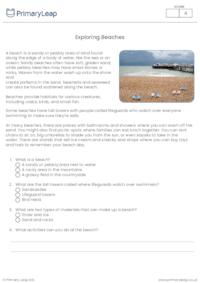
KS1 Exploring Beaches Worksheet"Exploring Beaches" offers a comprehensive and engaging resource for KS1 geography lessons, providing students with a deeper understanding of coastal environments. Following the exploration of beaches, students will engage in comprehension questions that reinforce their understanding of the material covered. These questions are designed to assess students' knowledge of beach features and their ability to recall information from the passage.Educational Goals:Understand what beaches are and where they're found.Recognise and describe natural and human-made features of beaches.Practise reading and comprehension skills in a fun and relaxed setting.Develop a love for exploring nature and the great outdoors.
 New
New

Created for KS1 geography lessons, this worksheet encourages young adventurers to explore the depths of the ocean while expressing their creativity through colouring. Students will embark on an exciting journey to discover the largest creature in the ocean, the magnificent blue whale.Fun Facts about Blue Whales:Blue whales are the largest animals on Earth, growing up to 100 feet long and weighing as much as 200 tons.They have a deep blue-grey colouration and a distinctive mottled appearance.Blue whales consume up to 4 tons of krill, their primary food source, in a single day.Their powerful vocalizations, known as whale songs, can be heard across vast distances in the ocean.Blue whales undertake long migrations between feeding and breeding grounds.
 New
New

Embark on a thrilling Arctic adventure with our Walrus Colouring Activity! Tailored for KS1 geography lessons, this worksheet invites young explorers to journey to the icy waters of the Arctic while expressing their creativity through colouring. Introduce students to intriguing tidbits about walruses, such as their impressive tusks, blubbery bodies, and unique adaptations for Arctic survival. Learning about these remarkable creatures adds excitement and curiosity to the colouring experience.Fun Facts about Walruses:Walruses are large marine mammals that inhabit the Arctic Ocean and surrounding seas.They are known for their distinctive tusks, which are elongated canine teeth used for various purposes, including foraging and defence.Walruses have a thick layer of blubber that helps them stay warm in cold Arctic waters.They use their sensitive whiskers to detect food on the ocean floor, such as clams and other shellfish.Walruses are highly social animals and often gather in large groups, known as herds, on land and ice floes.
 New
New

Colouring has been shown to have calming effects on students, promoting relaxation and reducing stress levels. This activity provides a tranquil and enjoyable learning experience, allowing students to unwind as they connect with the ocean and its inhabitants. Tailored for KS1 geography lessons on the five oceans, this worksheet invites young learners to embark on an exciting journey through the depths of the sea while expressing their creativity through colouring.Fun Facts about Dolphins:Dolphins are highly intelligent mammals, known for their complex social behaviours and communication skills.They use echolocation, a type of sonar, to navigate and locate prey underwater.Dolphins are incredibly playful animals and often engage in acrobatic displays, riding waves and leaping out of the water.Some dolphin species, such as the bottlenose dolphin, can swim at speeds of up to 20 miles per hour.Dolphins are known for their strong bonds with each other and often form close-knit groups called pods.
 New
New

Colouring has calming effects on students, promoting relaxation and reducing stress levels. This activity provides a peaceful and enjoyable learning experience, allowing students to unwind as they dive into the world of seahorses. Perfect for KS1 geography lessons on the five oceans, this worksheet invites young explorers to dive into the whimsical realm of seahorses while unleashing their creativity through colouring.
 New
New
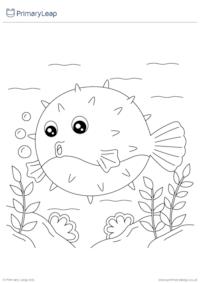
Embark on an undersea journey filled with wonder and excitement with our delightful Pufferfish Colouring Activity! This engaging worksheet is designed to accompany KS1 geography lessons on the five oceans, offering young learners an opportunity to discover the unique charm of the pufferfish while unleashing their creativity through the art of colouring. Introduce students to some fascinating facts about pufferfish, such as their ability to inflate themselves when threatened and their unique defence mechanisms. Learning about these quirky characteristics adds an element of fun and curiosity to the colouring activity.
 New
New

Spark your students' sense of wonder and curiosity with our Lobster Colouring Activity, a delightful addition to your KS1 geography lessons on the five oceans. Through the exploration of marine life, students embark on a journey of discovery and creativity, deepening their connection to the natural world and fostering a lifelong appreciation for the beauty and diversity of ocean ecosystems.
 Free
Free

Ignite your students' curiosity and imagination with this Stingray Colouring Activity, a perfect addition to your KS1 geography lessons on the five oceans. Through the exploration of marine creatures, students embark on a journey of discovery and creativity, fostering a deeper connection to the natural world and the wonders that lie beneath the waves.
 New
New
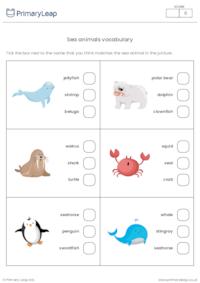
Incorporating this sea animal identification worksheet into KS1 geography lessons not only adds an element of excitement and engagement but also empowers students to actively explore and appreciate the wonders of the natural world. Tailored specifically for KS1 students, this worksheet provides a dynamic platform for young learners to delve into the captivating world of marine life while honing essential academic skills.
 New
New
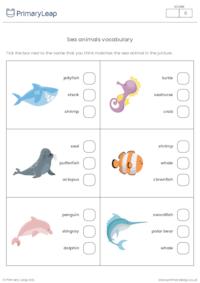
Sea Animals Vocabulary WorksheetThis sea animal identification worksheet is a fantastic addition to KS1 geography lessons, offering a fun way for students to learn about the five oceans and the creatures that inhabit them. By engaging with colourful illustrations and multiple-choice options, children can deepen their understanding of marine ecosystems while honing their academic skills in an enjoyable way.




Check out our ready-to-use worksheets that can be used in the classroom or at home. Simply download or print and watch your child’s confidence grow with our easy to follow printables.


One of the best things about printable worksheets is that they make learning fun and easy. Explore our educational resources based on and keep your children learning through these fun and engaging exercises.


Our printable worksheets are designed for progressive learning. Our engaging content enables a child to learn at their own speed and gain confidence quickly. When we help a child believe in themselves, we empower them for life.


Printable worksheets are a great way to enhance creativity and improve a child’s knowledge. Help your child learn more about with this great selection of worksheets designed to help children succeed.
An email has been sent to your account please activate your account to continue.

PrimaryLeap has introduced a new interactive learning platform and would like to offer you a completely Free Upgrade.
We understand that you may only want to use our services for worksheets and may not want to upgrade your account.
But if you are interested in trying out our new services then you're just a click away.
An email has been sent to your account please activate your account to continue.
You've answered
and have 2 Questions remaining
Import multiple students information through a CSV File. Browse or drag .CSV file below.